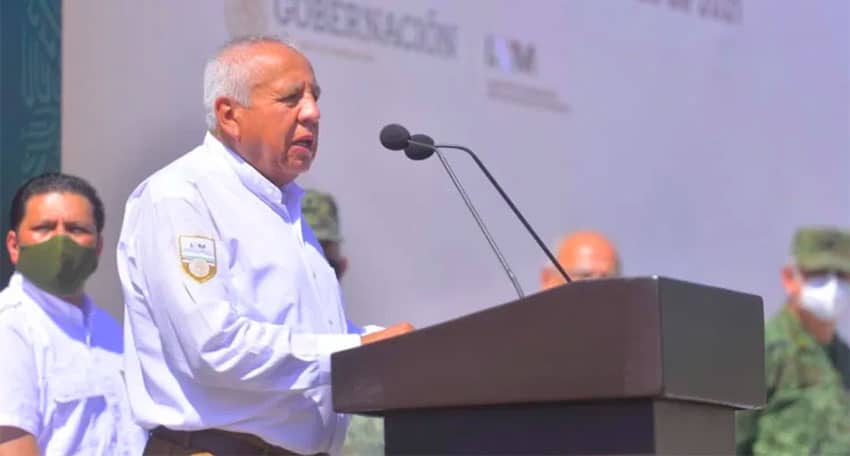More than 35,000 migrants have entered Mexico over the past three months via the border with Guatemala in Tabasco, the head of the National Immigration Institute (INM) said Tuesday as the federal government held talks with its United States counterpart to canvass ways to reduce migration to the Mexico-U.S. border.
Francisco Garduño said Central American migrants, guided in some cases by criminal groups, are entering Mexico via the Grijalva River in Tabasco. He said that INM personnel, supported by the army, navy, National Guard, state police and Civil Protection authorities, will bolster security on the southern border to stem the rising flow of migrants attempting to reach the United States to seek asylum or enter that country illegally.
“We have to patrol El Ceibo [a border community in Tabasco] and Tenosique [a municipality that borders Guatemala],” Garduño said during a visit to state capital Villahermosa.
“A lot of migrants are now passing in boats via the Grijalva River. They’re taking another route [to enter Mexico], it’s no longer the Ciudad Hidalgo route,” he said, referring to the southern border town south of Tapachula in Chiapas.
“Every time we patrol a regular or irregular access point, the smugglers or [human] traffickers obviously take other paths and surveillance becomes more difficult.”
The INM chief said that security needs to be bolstered on the southern border to combat human trafficking as well as drug trafficking and other crimes.
“We’re applying the law of controlled, safe migration,” Garduño said, adding that adult migrants are using children as “passports” to travel though Mexico to the United States.
He said that last weekend alone more than 1,000 migrants entered the country illegally via the border in Tabasco. They face a range of dangers, Garduño added.
“It’s a dangerous area of snakes and jaguars; they reach the river and hire some boats to travel to dry land. That’s what we have to avoid,” he said.
Some migrants walk for about a week to reach Palenque, Chiapas, after entering the country in Tabasco, facing additional risks, including dehydration, along the way.
Garduño said that federal authorities will target people who profit off migrants by promising to guide them into Mexico and to the United States.

“We must attack networks that organize [migrant] caravans,” he said, adding that they charge migrants – “honest people with desires and new hopes” – up to US $4,500.
The federal government closed the southern border to nonessential traffic last Friday, ostensibly as a measure to control the spread of the coronavirus virus. But although both Mexico and the United States denied there was a quid pro quo, the move was widely seen as a concession to the U.S. government, which announced that it would send 2.5 million Covid-19 vaccines to Mexico the same day the closure was announced.
It remains to be seen how effective the southern border closure – currently scheduled to remain in force until April 22 – will be in stemming the flow of migrants to the northern border, where large numbers of people, encouraged by the change in the U.S. government, have recently arrived to attempt to seek asylum.
The Washington Post reported that the new U.S. government is “desperate for help from Mexico to contain what’s on track to be the biggest surge in irregular migration in 20 years.”
In that context, a United States delegation led by southern border coordinator Roberta Jacobson, a former ambassador to Mexico, traveled to Mexico City on Tuesday to meet with officials, including Foreign Minister Marcelo Ebrard.
According to Emily Horne, a U.S. National Security Council spokeswoman, the U.S. officials were seeking to “develop an effective and humane plan of action to manage migration” with their Mexican counterparts.
The Ministry of Foreign Affairs said that Ebrard and Jacobson discussed “mechanisms of cooperation that promote orderly, safe and regular migration in the region.”
The United States Embassy in Mexico subsequently published a voice message to social media in which Jacobson urges migrants not to travel to the U.S. because “the border is closed.”
The meeting came a day after Defense Minister Luis Cresencio Sandoval announced that 8,715 army and National Guard troops had been deployed to the southern and northern borders to detain undocumented migrants.
That number was reported as a significant bolstering of border security but according to Sam Storr, a Mexican military scholar who is a consultant to the the citizen security program at Ibero-American University, it’s only just above the average of 8,058 troops that were deployed to the borders in 2020.
In contrast, some 15,000 troops were deployed to the northern border alone in 2019 after former U.S. president Donald Trump threatened to impose blanket tariffs on Mexican goods if Mexico didn’t do more to stem the arrival of migrants.
As Garduño indicated, Central American migrants have continued to flow into Mexico via informal, rural border crossings despite the closure of the formal border last Friday.
Brenda Ochoa, director of the Fray Matías de Córdova human rights center in Tapachula, told the Post that the National Guard had deployed to the Suchiate River, which separates Guatemala from Mexico in Chiapas, but warned that the bolstered security there would likely push migrants to try to cross the border in more remote and dangerous areas – as has been occurring in Tabasco.
“They will look for other ways to get in and take more risks,” she said.
Irregular migration to the U.S. border from countries such as Guatemala, Honduras and El Salvador decreased significantly after Mexico ramped up enforcement to stave off the tariffs threatened by Trump but has surged recently due to a range of factors including coronavirus-induced economic crises, destruction caused by two powerful hurricanes that slammed into Central America last year, the end of strict coronavirus lockdowns and a belief that the administration of U.S. President Joe Biden will be more welcoming to migrants.
Source: El Universal (sp), The Washington Post (en), Milenio (sp)
